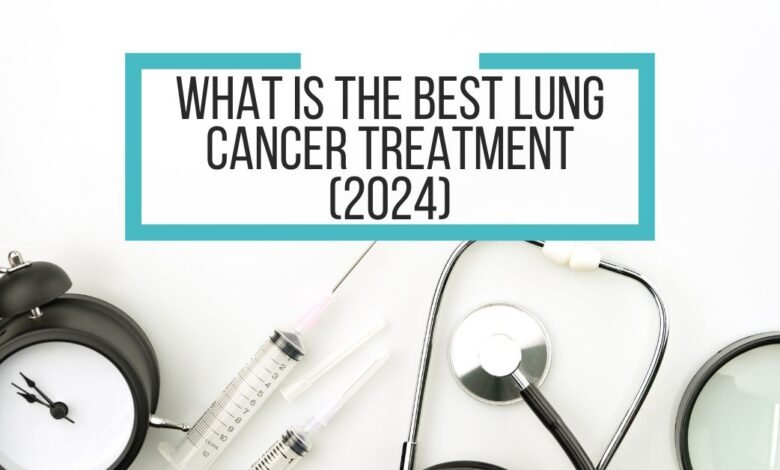What is The Best Lung cancer treatment (2024)?
Lung cancer remains one of the most prevalent and deadly cancers worldwide, but advancements in treatment continue to improve outcomes for patients

Lung cancer remains one of the most prevalent and deadly cancers worldwide, but advancements in treatment continue to improve outcomes for patients. As of 2024, several therapeutic strategies are employed based on the type of lung cancer, stage of the disease, and individual patient factors. This comprehensive overview explores the most effective treatments currently available, focusing on non-small cell lung cancer (NSCLC) and small cell lung cancer (SCLC), the two primary types of lung cancer.
Understanding Lung Cancer Types
Non-Small Cell Lung Cancer (NSCLC): This type accounts for approximately 85% of lung cancer cases. It includes subtypes like adenocarcinoma, squamous cell carcinoma, and large cell carcinoma. NSCLC is typically treated based on the stage of cancer—localized, locally advanced, or metastatic.
Small Cell Lung Cancer (SCLC): Representing about 15% of lung cancers, SCLC tends to grow and spread more rapidly than NSCLC. Treatment often involves chemotherapy and radiation, given the aggressive nature of this cancer.
Current Treatment Modalities
1. Surgery
For early-stage NSCLC, surgery remains a cornerstone of treatment. Lobectomy (removal of a lobe of the lung) is the most common procedure, but pneumonectomy (removal of an entire lung) or wedge resection (removal of a small section) may be performed based on tumor size and location.
- Indications: Patients with stage I or II NSCLC are typically candidates for surgery.
- Outcomes: Surgical resection can lead to long-term survival, especially when combined with adjuvant therapies like chemotherapy.
2. Chemotherapy
Chemotherapy plays a crucial role in both NSCLC and SCLC, particularly in advanced stages. It utilizes drugs to kill rapidly dividing cancer cells.
- NSCLC: In advanced NSCLC, chemotherapy is often used in conjunction with targeted therapies or immunotherapy. Common regimens include combinations of carboplatin, paclitaxel, and pemetrexed.
- SCLC: For extensive-stage SCLC, first-line treatment usually involves a combination of cisplatin or carboplatin with etoposide.
Recent studies indicate that chemotherapy can enhance the efficacy of immunotherapy and targeted therapies, making it a vital component of a multi-faceted treatment approach.
3. Radiation Therapy
Radiation therapy is commonly employed for both NSCLC and SCLC, especially in cases where surgery is not an option or as an adjunct to surgery.
- Local Control: In early-stage NSCLC, stereotactic body radiation therapy (SBRT) offers a non-invasive alternative for patients who cannot undergo surgery.
- SCLC: Radiation is essential in the treatment of SCLC, particularly for localized disease. Prophylactic cranial irradiation (PCI) may also be used to prevent metastasis to the brain.
4. Targeted Therapy
Targeted therapy has revolutionized the treatment of NSCLC, especially in patients with specific genetic mutations.
- EGFR Inhibitors: Drugs like osimertinib are effective in patients with EGFR mutations, providing improved survival rates.
- ALK Inhibitors: Alectinib and crizotinib are used for patients with ALK gene rearrangements.
- Other Targets: Emerging therapies targeting ROS1, BRAF, and MET mutations are also expanding the arsenal against NSCLC anal cancer.
These therapies are often combined with chemotherapy and immunotherapy to enhance treatment effectiveness.
5. Immunotherapy
Immunotherapy harnesses the body’s immune system to fight cancer and has become a significant advancement in lung cancer treatment.
- Checkpoint Inhibitors: Drugs like pembrolizumab and nivolumab target PD-1/PD-L1 pathways, which are often exploited by tumors to evade immune detection. These agents have shown promising results, particularly in NSCLC.
- Combination Approaches: Combining immunotherapy with chemotherapy has emerged as a powerful strategy, improving response rates and overall survival in advanced NSCLC.
6. Clinical Trials and Emerging Therapies
Ongoing research and clinical trials continue to refine and develop new treatment strategies. Personalized medicine, which tailors treatment based on the genetic makeup of the tumor, is gaining traction. Additionally, therapies that target tumor microenvironments and epigenetic changes are under investigation.
7. Supportive Care and Palliative Treatment
For patients with advanced lung cancer, supportive care is critical. This includes:
- Symptom Management: Addressing pain, breathlessness, and other symptoms significantly improves quality of life.
- Nutritional Support: Many patients experience weight loss and malnutrition, making dietary interventions vital.
- Psychosocial Support: Counseling and support groups can help patients and families cope with the emotional aspects of cancer diagnosis and treatment.
Conclusion
The best lung cancer treatment in 2024 involves a multidisciplinary approach that integrates surgery, chemotherapy, radiation, targeted therapy, and immunotherapy. The choice of treatment is highly individualized, depending on tumor characteristics, patient health, and preferences.
While challenges remain, particularly in the realms of early detection and managing resistant disease, advancements in molecular biology and immunotherapy provide hope for improved outcomes. Ongoing research and clinical trials continue to drive progress, aiming for more effective, less toxic treatment options. As our understanding of lung cancer evolves, the future looks promising for patients navigating this challenging diagnosis.
Read more – (Click here)


